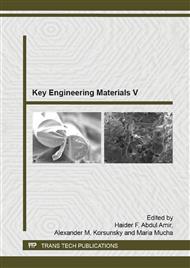[1]
J. H. Park, Deposition-Temperature Effects on AZO Thin Films Prepared by RF Magnetron Sputtering and Their Physical Properties, vol. 49, no. December, p.584–588, (2006).
Google Scholar
[2]
V. Fathollahi and M. M. Amini, Sol – gel preparation of highly oriented gallium-doped zinc oxide thin films, September, p.235–239, (2001).
DOI: 10.1016/s0167-577x(01)00231-2
Google Scholar
[3]
T. Prasada Rao, M. C. Santhosh Kumar, and N. Sooraj Hussain, Effects of thickness and atmospheric annealing on structural, electrical and optical properties of GZO thin films by spray pyrolysis, J. Alloys Compd., vol. 541, p.495–504, Nov. (2012).
DOI: 10.1016/j.jallcom.2012.05.128
Google Scholar
[4]
M. Willander, O. Nur, Q. X. Zhao, L. L. Yang, M. Lorenz, B. Q. C, a El-Shaer, Zinc oxide nanorod based photonic devices: recent progress in growth, light emitting diodes and lasers., Nanotechnology, vol. 20, no. 33, p.332001, Aug. (2009).
DOI: 10.1088/0957-4484/20/33/332001
Google Scholar
[5]
S. Senthilkumaar, K. Rajendran, S. Banerjee, T. K. Chini, and V. Sengodan, Influence of Mn doping on the microstructure and optical property of ZnO, Mater. Sci. Semicond. Process., vol. 11, no. 1, p.6–12, Feb. (2008).
DOI: 10.1016/j.mssp.2008.04.005
Google Scholar
[6]
M. Y. Ghotbi, Nickel doped zinc oxide nanoparticles produced by hydrothermal decomposition of nickel-doped zinc hydroxide nitrate, Particuology, vol. 10, no. 4, p.492–496, Aug. (2012).
DOI: 10.1016/j.partic.2011.11.005
Google Scholar
[7]
T. Nam, C. W. Lee, H. J. Kim, and H. Kim, Growth Characteristics and Properties of Ga-doped ZnO (GZO) Thin Films Grown by Thermal and Plasma-enhanced Atomic Layer Deposition, Appl. Surf. Sci., p.2–7, Jan. (2014).
DOI: 10.1016/j.apsusc.2014.01.027
Google Scholar
[8]
Z. Zhang, C. Bao, S. Ma, L. Zhang, and S. Hou, Effects of deposition power and pressure on the crystallinity of Al-doped ZnO thin films at glass substrates by low temperature RF magnetron sputtering, vol. 48, p.214–222, (2012).
DOI: 10.1016/j.spmi.2011.04.002
Google Scholar
[9]
V. Assuncao, I. Ferreira, R. Martins, E. Fortunato, A. Marques, and H. Aguas, Influence of the deposition pressure on the properties of transparent and conductive ZnO : Ga thin-film produced by r . f . sputtering at room temperature, vol. 427, p.401–405, (2003).
DOI: 10.1016/s0040-6090(02)01184-7
Google Scholar
[10]
N. Manjula, K. Usharani, A. R. Balu, and V. S. Nagarethinam, Studies on the Physical Properties of three Potentially important TCO Thin Films fabricated by a Simplified Spray Technique under same Deposition conditions, vol. 6, no. 1, p.705–718, (2014).
Google Scholar
[11]
D. -H. Lee, K. Kim, Y. S. Chun, S. Kim, and S. Y. Lee, Substitution mechanism of Ga for Zn site depending on deposition temperature for transparent conducting oxides, Curr. Appl. Phys., vol. 12, no. 6, p.1586–1590, Nov. (2012).
DOI: 10.1016/j.cap.2012.05.009
Google Scholar
[12]
S. Lee, S. -H. Kim, Y. Kim, A. I. Kingon, D. C. Paine, and K. No, Structural and electrical properties of transparent conducting Al2O3-doped ZnO thin films using off-axis DC magnetron sputtering, Mater. Lett., vol. 85, p.88–90, Oct. (2012).
DOI: 10.1016/j.matlet.2012.06.094
Google Scholar
[13]
X. -Y. Li, H. -J. Li, Z. -J. Wang, H. Xia, Z. -Y. Xiong, J. -X. Wang, and B. -C. Yang, Effect of substrate temperature on the structural and optical properties of ZnO and Al-doped ZnO thin films prepared by dc magnetron sputtering, Opt. Commun., vol. 282, no. 2, p.247–252, Jan. (2009).
DOI: 10.1016/j.optcom.2008.10.003
Google Scholar
[14]
C. Chu, H. Wu, and J. Huang, Influence of working pressure on structural and optoelectronic properties of Al-doped ZnO thin films, p.569–572, (2014).
DOI: 10.1109/is3c.2014.155
Google Scholar


